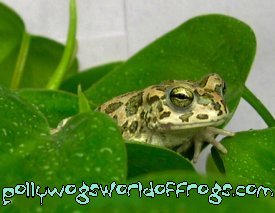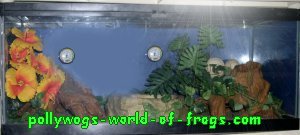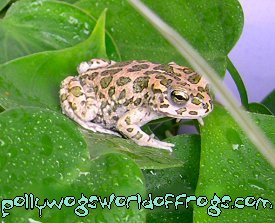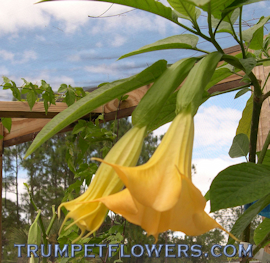Caresheet Bufo Viridis
 Bufo viridis has many common names, such as the European green toad, Moroccon toad,
and in Spanish, Sapo verde. Males reach about 2 1/2" to 3 1/4", whereas females have been reported to
reach as much as 4". This personable little bufo has well defined green
markings on his dorsal area, usually having a darker green edge than the center variegated spot.
The frog himself is a beige or tan color. His paratoid glands are oval and
found parallel to each other rather than diverging. No cranial crests are present
on this little fellow.
Bufo viridis has many common names, such as the European green toad, Moroccon toad,
and in Spanish, Sapo verde. Males reach about 2 1/2" to 3 1/4", whereas females have been reported to
reach as much as 4". This personable little bufo has well defined green
markings on his dorsal area, usually having a darker green edge than the center variegated spot.
The frog himself is a beige or tan color. His paratoid glands are oval and
found parallel to each other rather than diverging. No cranial crests are present
on this little fellow.
 In his native habitat, this toad is found in Europe east of the Rhine River,
and includes the southern tip of Sweden, the Baleric islands, Corsica, Sardinia, western Asia, including Iran,
Mongolia and China, southwestern Asia and the Arabian pennisula. Also found
in northern Africa, Libya, and of course, Morocco.
In his native habitat, this toad is found in Europe east of the Rhine River,
and includes the southern tip of Sweden, the Baleric islands, Corsica, Sardinia, western Asia, including Iran,
Mongolia and China, southwestern Asia and the Arabian pennisula. Also found
in northern Africa, Libya, and of course, Morocco.
A nocturnal toad, he is often found in cities where they congregate around street lamps to search for insects that also fly in towards the light. Their call is a high pitched trill that last from 8 to 10 seconds. It actually sounds more like a chirp to me. Like most toads, they sound more birdlike than frog-like, (one of the benefits of owning bufos if you enjoy mother nature's songs) Small, black eggs are laid in the typical toad-string fashion. The tadpoles are also small, being only 1/2" to 2/3".
Setup
In his natural home, bufo viridis can be found in open, drier lowland areas when found
in Europe and in more mountainous areas in the Asian region. Mine prefer to have a
large pool or fountain in which to soak...
 I have one who loves the water dish!
Give one at least a 15 litre tank, and two or more 20 and up, wider more than tall, as
they are not arboreal. Their skin stays wetter than normal bufos, akin to the
Fire belly toads, so I use foam substrate with a scattering of rocks here and there.
Their feet seem delicate and this is a softer substrate than regular gravel. You
could also use the packaged moss sold in herp shops, but I worry too much about
impaction, especially if yours are young, small toads. Finely crumbled and dampened peat moss is another substrate you could use with them.
I have one who loves the water dish!
Give one at least a 15 litre tank, and two or more 20 and up, wider more than tall, as
they are not arboreal. Their skin stays wetter than normal bufos, akin to the
Fire belly toads, so I use foam substrate with a scattering of rocks here and there.
Their feet seem delicate and this is a softer substrate than regular gravel. You
could also use the packaged moss sold in herp shops, but I worry too much about
impaction, especially if yours are young, small toads. Finely crumbled and dampened peat moss is another substrate you could use with them.
 Humidity levels should be between 40% and 55%, temperatures can range between
68° and 80° in daytime. Provide them with outcroppings of shale and
silk or live plants, and a cave or two to hide in.
Humidity levels should be between 40% and 55%, temperatures can range between
68° and 80° in daytime. Provide them with outcroppings of shale and
silk or live plants, and a cave or two to hide in.
Lighting can be daylight blue or daylight fluorescent, and use a red light to view at night if you wish. Mine come out in the day as well, so you may not need to use red lighting. Although they will appear in the daytime, if you over handle them, it will make them more timid than they already are, so keep your hands away from them as much as possible.
 Thoroughly clean the tank about once a month, and use Quat to scrub everything, rinse well in
spring water before returning the toads to their home. If you are using a pool of
water with no filtration, clean the pool daily...they poop and pee in it...ammonia
buildup can then penetrate their skin, making them sick. With biological filtration on
a medium sized pool, once a week change 3/4 of the water, replacing it with spring or treated
water.
Thoroughly clean the tank about once a month, and use Quat to scrub everything, rinse well in
spring water before returning the toads to their home. If you are using a pool of
water with no filtration, clean the pool daily...they poop and pee in it...ammonia
buildup can then penetrate their skin, making them sick. With biological filtration on
a medium sized pool, once a week change 3/4 of the water, replacing it with spring or treated
water.
Feed them insects every other evening, 3 to 4 insects per frog. Vary their diet with chopped earthworms (chop a nightcrawler into about 3 pieces for 2" toads), crickets, superworms, or use whole redworms, white grubs, fly maggots, flies, cutworms from organic garden, pillbugs, pale brown moths and termites. Vitamin dust their insects every two weeks. Feed them less when weather cools, as frogs digestive system will then slow.
Something kind've funny to mention... it has been written in several books and journals that this frog would rather starve than eat an earthworm. This is sooo not true! Mine love them, and they are very healthy for them, as they contain no chitin which can impact them if over-fed lots of hard-shelled insects.
Do not handle this anuran unless absolutely necessary, and then use Proper procedures.
Further Onsite Help
Basic Frogcare (choosing healthy frogs, species mixing, feeding, etc.)
Vivariums (to establish and maintain, lighting, substrate ideas, etc.)
Quarantine (keeping vivarium disease-free, how to set up quarantine tank)
Water 101 (How to establish & maintain high quality water)
Raising Insects (Info about raising your own insects, including grubs)
Frog Breeding (Savannah style setup information)


